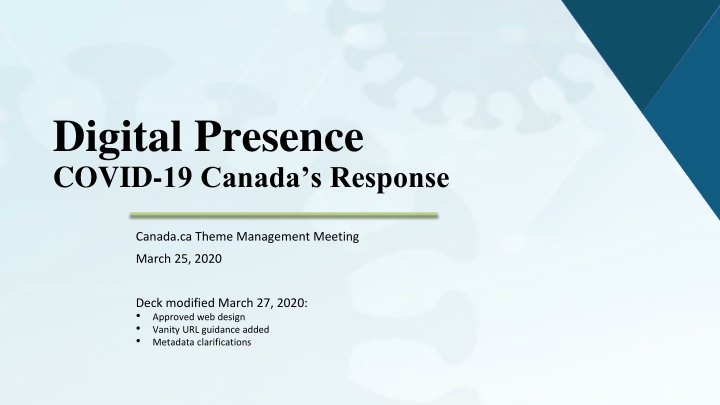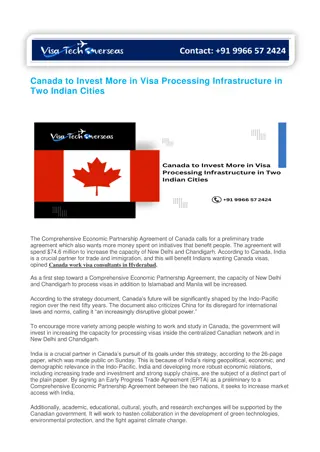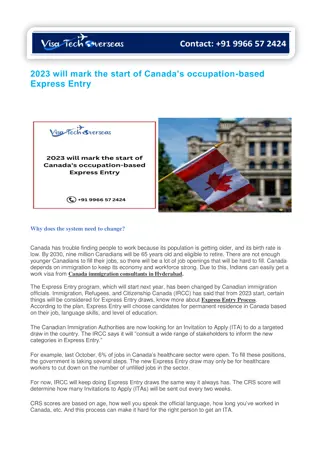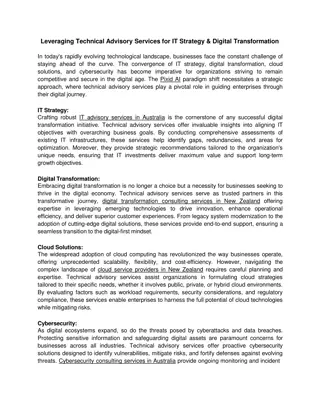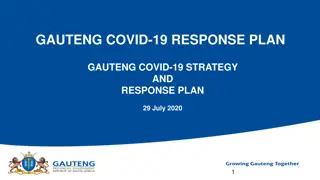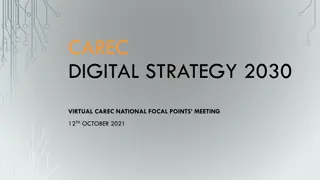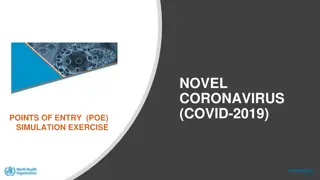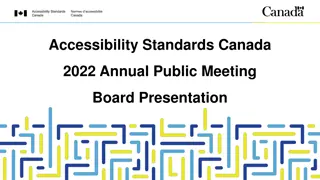COVID-19 Canada's Digital Response Strategy
This deck modified on March 27, 2020, outlines Canada's digital response strategy to COVID-19. It covers roles, current web space, digital communications strategy, web design, implementation tools, performance measurement, and action items. The focus is on guiding online efforts for an all-of-Government digital presence supporting public education, safety, and financial support requests during the pandemic.
Download Presentation

Please find below an Image/Link to download the presentation.
The content on the website is provided AS IS for your information and personal use only. It may not be sold, licensed, or shared on other websites without obtaining consent from the author.If you encounter any issues during the download, it is possible that the publisher has removed the file from their server.
You are allowed to download the files provided on this website for personal or commercial use, subject to the condition that they are used lawfully. All files are the property of their respective owners.
The content on the website is provided AS IS for your information and personal use only. It may not be sold, licensed, or shared on other websites without obtaining consent from the author.
E N D
Presentation Transcript
Digital Presence COVID-19 Canada s Response Canada.ca Theme Management Meeting March 25, 2020 Deck modified March 27, 2020: Approved web design Vanity URL guidance added Metadata clarifications
Contents 1. Roles 2. Current web space 3. COVID-19 Digital Communications Strategy 4. Web design for all of Government presence 5. Implementation (overview and tools) 6. Performance measurement 7. Action items
Roles CPAB /TBS/PCO/PP Together: PHAC/HC-CPAB Support consistent communications on digital implementation plan (when approved) and web standards Lead website direction, strategy, implementation, communications and measurement THEME LEADS: TBS Review/advise on theme-space content requests, assess for duplication of content across Canada.ca Identify theme-space content inventory (existing and anticipated) to contribute to content mapping To apply Content, UTM, Vanity URL, Metadata Guidance where possible Lead optimization advice, testing, research, and coordination with theme partners Principal Publisher (PP) 24x7 Management of web content system, including analytics, metadata, redirects/Vanity, SEO
Current COVID-19 web space By the numbers* at PHAC/HC-CPAB: 453 requests since launch 2246 pages (mostly updates) 15-20 web publishing staff** 8 digital comms advisors** with O/T 8 digital transformation staff** (strategic, ux, SEO/metadata, analytics) Main PHAC Landing page Partner landing pages Many Vanity URLs Increasing content pages Increasing navigation structure Interactive components Virtual Assistant Self-Assessment tool *as of March 24, 2020 **includes management
COVID-19 Digital Communications Strategy The overarching digital strategy aims to guide online efforts to provide: An all of Government digital presence that supports public education, safety/security of Canadians and enables financial support requests. Flexibility and responsiveness to audience needs throughout the duration of the pandemic. Cohesive messaging on COVID-19, its health, safety, security, social and economic impacts, and what the Government s response is. Map of what should be published where, why, and how we define success and improvement over time.
COVID-19 web presence RECOMMENDED STRUCTURE USABILITY TESTING Grouping pages by task categories (similar to WHO) to enable scalability Mobile-first design approach to see more links without scrolling (70% of visitors are accessing by phone) More bullets/tasks vs paragraph writing style (easier to read/scroll quicker to update) Content tagging for higher search results placement, and back-end content management TBS-DTO recently performed usability testing on a prototype with mobile users indicating: task-based design enable users to succeed at finding the right answers that there was difficulty on reading/accessing print based content such as .pdfs, large tables, complex images
Desktop view (current vs. future) OPTIMIZED APPROACH Task-based, can add or remove links as needed Concept is scalable, easy to scroll through Iterative/adaptable approach Can consider : Social feeds collaboration to reduce duplication
Mobile view (current vs. future) OPTIMIZED APPROACH Usability testing on a prototype with mobile users, users had a 90% success rate finding the answers they were seeking on COVID-19. Previous research also supports task-based design.
Implementation: Phased approach Phase I with capacity (ASAP) Incorporate task-based structure with existing links to content Validate content map with PHAC/HC-CPAB and OGDs Assess ability to reduce paragraph format with minimal edits Assess content against Crisis communications checklist (Annex A) Support product development and branding use Phase 2 with capacity Implement content map All new content aiming to follow the crisis communications checklist Assess and encourage reduction of duplicated content between OGDs Apply additional web editing where approved Continue user testing
Initial Visualization - Content mapping and scaling (TBC) Financial support: For businesses For individuals For Canadians abroad Taxes (CRA) Safety and security: Travel Airports and border measures Securing medical supplies (DND/PHAC) Your Charter Rights (JUS) Workplace health and safety (ESDC) Medical research (PHAC) Drug shortage reporting (HC) Quarantine measures (PS/RCMP/PHAC) Current situation: Outbreak update Latest announcements Canada s response Your health: Be prepared Symptoms and treatment Prevention and risks How to self-isolate Awareness resources Mental health (PHAC) Rapid diagnosis (mobile tests) (PHAC)
Content inventory validation and mapping Meeting request included access to content inventory, which is accessible outside the GC network: https://wiki.gccollab.ca/Covid_19_DTO-BTN Engage theme partners to contribute to the list: existing content anticipated content NEXT STEP - PHAC/HC & Partners to validate content mapping
Branding and accessibility Through work of our Creative Services, Strategic and Digital Comms teams, we have updated the branding elements for all of Government to access: https://gcconnex.gc.ca/file/group/61785806/all# Check accessibility against WCAG during content development and publishing.
Vanity URLs Use main URLs for promotion: Canada.ca/coronavirus Canada.ca/le-coronavirus Strictly limit creation of new vanity URLs related to COVID-19 and only create if it s absolutely necessary. Use task or topic keywords in vanity URLs, instead of department acronym: canada.ca/coronavirus-taxes or canada.ca/coronavirus-business URL guidance: design.canada.ca > Content and Information Architecture Specification > Organizing content > URL model
Metadata guidance OVERARCHING CONSIDERATIONS Unique titles should be used for each page across Canada.ca Frontload important terms in metatitle noting Google search display limited to 600 pixels (about 70 characters) Create quality metatitle before web page goes live to ensure easier collection and interpretation of performance measurement results Include words that are commonly used (check through Adobe Experience Cloud and Google Trends) Tools are available through Principal Publisher to help relevant content rank more highly in Canada.ca search results Use http://requestform.portal.gc.ca/tickets.html to submit requests
Performance Measurement approach Align UX and Analytics to measure, report and improve online tasks to ensure Canadians can easily find and use content. Data aims to support evidence-driven decisions. Since launch (to March 24, 2020): Total visits: 42.7M visits KPI CREATION Task success rate % of visits to a priority page % of visits with onsite searches Are Canadians able to find what they need? Are Canadians able to use the information easily? Are there improvements to be made? Are we building content out from the landing page effectively? REPORTING Daily status Weekly report Monthly comprehensive report
UTM Guidance There is no need to tag Canada.ca pages linking within Canada.ca. These are tracked automatically. APPLY UNIQUE TAGS TO: Multiple pages residing outside Canada.ca each linking to the main COVID-19 landing page Email messages to stakeholder groups Specific social media posts vs. tracking channel NOTE: Never use the Vanity URL as the hyperlink embedded in the content REMEMBER TO: Use covid-1920 for the campaign name Place target link (if you have one) after the utm code, and at the very end of the href (or it will not work) Identify language (en for English and fr for French) Use underscores for spaces (there are no spaces or capital letters in UTM codes)
UTM Guidance and contact A UTM generator guide is available from Health Canada, complete with examples, to help you create your link. Please send your completed UTM codes and/or questions, to Health Canada s performance measurement team: hc.healthwebanalytics-analysewebdelasante.sc@canada.ca
Action items Given how quickly the communications are moving on this file, we are seeking help from Theme Leads to prioritize: - Contributions to content inventory - Application of UTM tagging (especially out large outreach efforts) - Use of the main Vanity URL rather than creating new ones - Use of approved branding
How to join GCconnex group To access the files, you need to join GCconnex group - Coronavirus Shared Files: 1. Go into GCConnex 2. Select tab Groups 3. In the Search for groups box, enter coronavirus 4. Select Coronavirus Shared Files 5. Select the Join Group button
Crisis communications content design checklist Checklist developed by TBS and being shared with all Government Departments. Use a mobile-first style Do not duplicate content Follow a news-based page structure Add the date and timestamp when information changes Follow guidance for alerts and warnings Write information as directions Use headings as answers Use bulleted lists Use bold text sparingly Pull links out of paragraphs Keep sentences short Check words to avoid Keep track of common wording and terms Identify pages with emergency-related content Create web content, not documents Apply accurate, relevant metadata https://design.canada.ca/crisis/content.html
Metadata guidance Impacting external search result ranking (i.e. Google) METATITLE (appears in search results as title) should accurately summarize the page content = your elevator pitch unique information to distinguish your content from similar pages on Canada.ca front load by putting the most important, relevant and used terms at the beginning of the title H1 (title appearing on web page) apply unique titles in relation to all of Government approach short, yet meaningful titles follow principles found in the Canada.ca Content Style Guide
Metadata guidance Mostly impacting internal search result ranking (Canada.ca) DESCRIPTION ranking factor in search results give users an accurate description of what they will find on a page - or task they can complete (should add context to title) do not simply repeat the title in this field KEYWORDS ranking factor in search results use keywords from title and text use common search terms no need to add variants of terms
